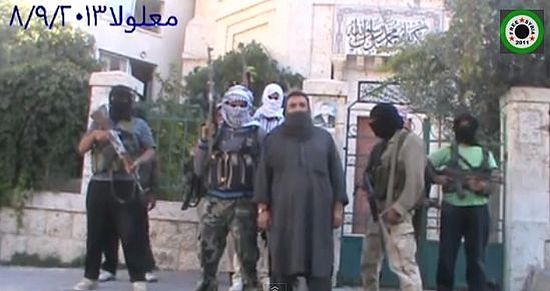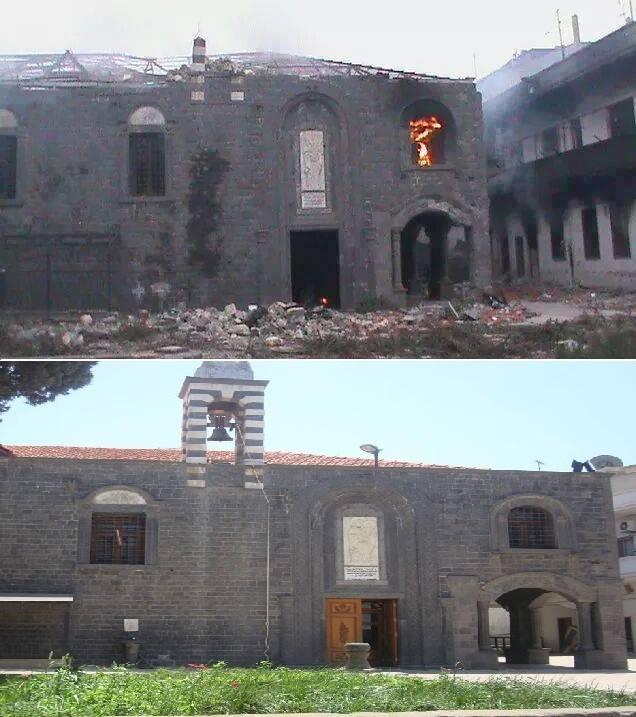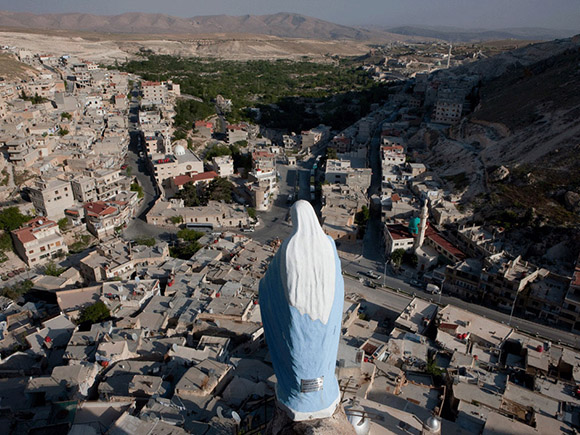The Monastery of St. Thekla, Ma’loula, Syria
It is a truly unique cultural heritage site, the hamlet of Ma’aloula, with Christian sanctuaries and monuments stretching back for more than 16 centuries into the past, yet it has been scarred, traumatized, desecrated and deeply wounded by the war in Syria.
Situated some 40 miles northeast of Damascus, Ma’loula is one of the few places in the world where Aramaic, the language spoken by Jesus Christ, is still spoken, but its Christian inhabitants feel they have been betrayed, not once but twice in the past year.

The first betrayal came from some of their Muslim neighbors who have shared the hamlet as good neighbors for 14 centuries. Until now, only ten percent of the pre-conflict population of approximately 4,000 (approximately 3,200 Christians and 600 Sunni Muslims) have dared to return, and there is little potable water and not much electricity.
Many of the Christians, mainly Antiochian Orthodox and Melkite Greek Catholics, fled to the Christian quarter of the Bab Touma neighborhood in the Old City of Damascus, and most remain there. Syrian forces retook the area on 4/13/14, four months after al-Nusra and other Islamist rebels overran it. This was after the jihadists had kidnapped 13 Ma’loula nuns and three maids on December 3, transporting them to the nearby town of Yabrud, until their release was negotiated and they were freed last March.
In May of this year, a couple of days after the liberation of Homs, this observer visited the Um al-Zennar Church, also known as the “Church of the Holy Belt,” located in the Old City.
What he witnessed and photographed at the time was the immediate aftermath of a rampage of desecration that had been inflicted on the church. This included the smashing of the altar and pews, the gouging out of the eyes of religious icons, the smashing of religious statues and destruction of paintings of saints, including Mary the mother of Jesus. Other damage included the burning of the nave and sanctuary as well as a still smoldering pile of bibles and religious documents in the courtyard. It was the worst desecration of a place of reverence and worship I had ever seen—until I came to Ma’loula.
The churches and monasteries here had attracted both Christian and Muslim pilgrims before the conflict. The monastery of Mar Thecla in fact has a reputation among believers for miraculous cures. This observer and his companion were given drops of holy water to splash in our eyes for good health and happiness. One can also drink water from the crack in the massive rock cliff that St. Thecla was said to have parted while fleeing the wrath of her family for turning from paganism to Christianity. Some religious scholars claim, and indeed a legend in the early church has it, that Thecla was a chaste and devoted follower of St. Paul. In any event, townspeople claim the water, which flows from the huge split rock, offers a cure for a variety of ailments.
Syrian Tourism Minister Bachir Yazigi has reported that damage and theft to antiquities in Syria, including during the fighting in Ma’loula has amounted to “billions of Syrian pounds” in losses. Included in his calculations are the following examples:
*Many of the old town houses and alleys have been destroyed. Roofs and walls of houses built of stone, in some cases three stories high have collapsed.
*A large number of caves and archaeological cemeteries have been vandalized, sabotaged, and drilled, their doors-smashed and turned into fortified barricades. One of the most damaged caves was on the site of Mar Sarkis, or the Monastery of St. Sergius and Bacchus;
The The Monastery of St. Thecla, including her tomb, has been completely burned, and its holy relics and icons looted, some already surfacing for illicit sale;
One lady from Ma’loula, now living in Damascus, explained to this observer how al-Nusra militants handed citizens “certificates of death” and threatened to harm women and children should the men fail to comply with whatever orders were given to them. She recalled how Christians were told to pay tributes to al-Nusra in order to stay alive.
Al-Nusra militants by the way are being identified as some of the most active dealers of black market antiques of the Middle East. Lebanese media have reported that a great number of ancient icons, crosses, reliquaries, and statues have been smuggled from Syria into Lebanon and then sent abroad. Local smugglers are said by INTERPOL to be moving hundreds of Ma’loula’s antiquities, transporting Christian antiquities to European countries, with the main destinations being Italy and Turkey.

The main entrance to St. Thecla’s Monastery and its main corridor have also been badly damaged and burnt. A fire was set in the Church of St. John the Baptist, located inside the monastery, and its contents—those which were not stolen—have been smashed, including the altar, the crosses, icons and frescos. Extremist phrases were written on the walls of the church, and many of the wall icons were painted over (in the ideology of some extremist groups the icons are forbidden to be seen).
At the nearby Monastery of St. Sergius and Bacchus—constructed in the early fourth century and one of the oldest monasteries in Syria—parts of the western and eastern walls have been substantially damaged by mortar shells. Additionally, the massive dome of the building has been destroyed, apparently hit by shells from different directions, and the bell removed. On the inside, the main marble altar lies destroyed, its wooden cross smashed. Drilling operations were carried out underneath the altar, apparently in search of treasure. All of the movable antiquities and holy items inside the monastery have been stolen, including the most important Maaloula icons.

And at the nearby Church of St. Leontius—the southern wall, the roof and the dome of the building have been damaged from shelling. Inside, the marble tabernacle is destroyed and holy items have been stolen, including the ancient church bell, which is claimed by locals to have been one of the most beautiful-sounding church bells in the world, second only perhaps to the bell at the Church of the Holy Sepulchre in Jerusalem. The crosses have been removed from above the domes of the church, and some of the valuable icons have been stolen, while others were burned. Wooden pews were piled high in the nave and set ablaze, an act of destruction which caused not only the incineration of the pews but which also set alight the wooden ceiling of the church.

No less tragic were the fates of two other world-famous monuments of Ma’loula. Extremists blew up the statue of Christ the Savior, which had adorned the entrance of St. Thecla Convent, as well as the statue of the Most Holy Virgin Mary, which stood on a cliff near the Safir Hotel, a domicile that was commandeered and ended up serving as al-Nusra’s main shelter for many months.
The Church of St. Cosmas and Damian was also destroyed, its altar and wooden iconostasis smashed and its valuable icons stolen. Elsewhere in the hamlet, the Church of St. Barbara was extensively damaged, with whatever valuables not carted off being burned. Even the more modern churches and shrines in the town have been completely looted and destroyed, including the shrines of Mar Saba and St. Thomas and the Church of St. Sherbin.
Throughout the community, what was inflicted by the invaders was wanton, mindless desecration.
Ma’loula is—and was—a beautiful ancient town, renowned for its religious tolerance. Its majority Christian population tried hard to resist the centrifugal pressures of a vicious, sectarian conflict. It failed through no want of trying. The day this observer visited the town, 9/23/14, was by coincidence a religious holiday, and the sisters returned with the orphans for a few hours. There was much joy, even among the ruins, and a bishop explained to me that solace and hope are still extended to the small number of townspeople remaining. As the voices of the few parishioners of St. Thecla flowed for a short while, filling the winding paths and alleys with praises to God and humanity, it seemed almost that even the hundreds of opened and vandalized burial caves on the mountainsides were touched, momentarily, by a sense of majesty and solemnity. And then the Sisters and orphans were parishioners were gone, returning to their hopefully safe quarters in Homs. It is hoped that those quarters will be only temporary, for Ma’loula sorely needs these residents to return to erase the ghost-town feeling of emptiness.
Ma’loula and its citizens urgently need governmental and international solidarity and assistance so as to begin the daunting task of resurrecting this formerly peaceful place of spirituality. A town motto that used to be cherished by the residents was (but is no more): “Everyone is a Christian and everyone is Muslim.” A couple of local residents who still remain and who seemed to be looking after the town, helpfully supplied much information to this observer during his visit, and after I had spent a wonderful but solemn day in their presence, both gentlemen swore to me that they would never forget, or forgive, the extreme Islamists who had desecrated and substantially gutted their village, along with its sacred sites, or the local Muslims who had been their neighbors but who had joined the rebels and helped destroy the town. They insisted that Ma’loula had been betrayed twice—once by their neighbors and a second time by the government, which shortly after town was liberated granted the criminals amnesty. Much bitterness remains over both of these perceived betrayals.
The two gentlemen also made a request of me: that as an American I take their story home and tell President Obama and American politicians about what happened here—and to ask for help rebuilding this Christian village.
ED: THE TWO GENTLEMEN STILL BETTING ON OBAMA AND AMERICAN POITIANS!!!!!!!
This report is in response to their request, and to honor my pledge to them that I would. May God protect them.
It was getting late and time to return to Damascus. A warning came from nearby soldiers stationed not far from a Hezbollah camp to be careful using the roads after dark. At this same moment, the five-year-old daughter of one of the townsmen who had toured some of the ruins and church buildings with us, looked up at her father with love and pride—this as the embittered gentleman, who had fought the al-Nusra invaders, shook hands and gazed into my eyes. And for a moment, both of our eyes filled with tears.
“No,” he said, “—no, we ask others to forgive our trespassers, and we must forgive those who trespassed against us. Christ Jesus taught us this. And we must turn the other cheek.”
His is a minority view in the town, I was told, but with those words from the Lord’s Prayer, I watched as this noble man wiped his eyes, and then he squeezed his young daughter’s hand. The five year old looked up at her baba and appeared to understand him, this as he gazed high up into the surrounding mountains, and directly at the mountain top remains of the As Safir Hotel where al Nusra had had its headquarters and from which it had rained mortars and rockets down on the defenseless village.
In the library of the Mar Sarkis monastery, just before leaving, I found a visitor’s book where visitors can write comments. One comment, signed by a lady from Boise, Idaho and still legible, reads:
“This is a very beautiful place to visit and also very inspirational to know that Christians have existed in this area continuously for so many years. May the work here in God’s name continue and help to bring peace and understanding to all people in the Middle East and the world, regardless of who or by what means they choose to worship God.”
Franklin Lamb is a visiting Professor of International Law at the Faculty of Law, Damascus University and volunteers with the Sabra-Shatila Scholarship Program (sssp-lb.com).


 The first betrayal came from some of their Muslim neighbors who have shared the hamlet as good neighbors for 14 centuries. Until now, only ten percent of the pre-conflict population of approximately 4,000 (approximately 3,200 Christians and 600 Sunni Muslims) have dared to return, and there is little potable water and not much electricity.
The first betrayal came from some of their Muslim neighbors who have shared the hamlet as good neighbors for 14 centuries. Until now, only ten percent of the pre-conflict population of approximately 4,000 (approximately 3,200 Christians and 600 Sunni Muslims) have dared to return, and there is little potable water and not much electricity. The main entrance to St. Thecla’s Monastery and its main corridor have also been badly damaged and burnt. A fire was set in the Church of St. John the Baptist, located inside the monastery, and its contents—those which were not stolen—have been smashed, including the altar, the crosses, icons and frescos. Extremist phrases were written on the walls of the church, and many of the wall icons were painted over (in the ideology of some extremist groups the icons are forbidden to be seen).
The main entrance to St. Thecla’s Monastery and its main corridor have also been badly damaged and burnt. A fire was set in the Church of St. John the Baptist, located inside the monastery, and its contents—those which were not stolen—have been smashed, including the altar, the crosses, icons and frescos. Extremist phrases were written on the walls of the church, and many of the wall icons were painted over (in the ideology of some extremist groups the icons are forbidden to be seen). And at the nearby Church of St. Leontius—the southern wall, the roof and the dome of the building have been damaged from shelling. Inside, the marble tabernacle is destroyed and holy items have been stolen, including the ancient church bell, which is claimed by locals to have been one of the most beautiful-sounding church bells in the world, second only perhaps to the bell at the Church of the Holy Sepulchre in Jerusalem. The crosses have been removed from above the domes of the church, and some of the valuable icons have been stolen, while others were burned. Wooden pews were piled high in the nave and set ablaze, an act of destruction which caused not only the incineration of the pews but which also set alight the wooden ceiling of the church.
And at the nearby Church of St. Leontius—the southern wall, the roof and the dome of the building have been damaged from shelling. Inside, the marble tabernacle is destroyed and holy items have been stolen, including the ancient church bell, which is claimed by locals to have been one of the most beautiful-sounding church bells in the world, second only perhaps to the bell at the Church of the Holy Sepulchre in Jerusalem. The crosses have been removed from above the domes of the church, and some of the valuable icons have been stolen, while others were burned. Wooden pews were piled high in the nave and set ablaze, an act of destruction which caused not only the incineration of the pews but which also set alight the wooden ceiling of the church.
















No comments:
Post a Comment